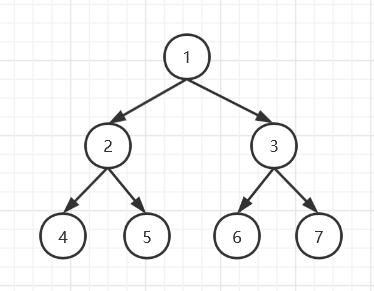一、递归打印
几个顺序
例: 对每个节点的左右节点进行递归,如下
对每个节点的左右节点进行递归,如下
public static void recursion(Node head){
if(head == null){
return;
}
//第1次打印
recursion(head.left);
//第2次打印
recursion(head.right);
//第3次打印
}
在递归左节点之前,可以第1次打印当前节点的值;当左节点递归结束后,代码继续往下执行,可以第2次打印当前节点;当右节点递归结束,代码继续往下执行,可以第3次打印当前节点,于是可以得到一个递归序,如下:
- **递归序:**1 2 4 4 4 2 5 5 5 2 1 3 6 6 6 3 7 7 7 3 1
- 先序遍历:1 2 4 5 3 6 7(递归序第一次出现的节点)
- 中序遍历:4 2 5 1 6 3 7(递归序第二次出现的节点)
- 后序遍历:4 5 2 6 7 3 1(递归序第三次出现的节点)
实现代码
/**
* 递归打印
* @param head 树的根节点
* @param printType 打印类型
*/
public static void recursion(Node head,String printType){
if(head == null) return;
//先序遍历打印处
if("first".equals(printType)){
System.out.print(head.value+" ");
}
recursion(head.left,printType);
//中序遍历打印处
if("mid".equals(printType)){
System.out.print(head.value+" ");
}
recursion(head.right,printType);
//后序遍历打印处
if("last".equals(printType)){
System.out.print(head.value+" ");
}
}
二、非递归打印
利用栈
先序遍历:
- 先将根节点压栈
- 每次从栈中弹出一个节点cur
- 打印(处理)cur节点
- 先将cur的右节点压栈,后将cur左节点压栈(如果有左右节点)
- 重复2~4过程直至栈为空
实现代码
public static void stackFirstPrint(Node cur){
Stack<Node> stack = new Stack<Node>();
stack.push(cur);//头结点先入栈
while(!stack.isEmpty()){
//弹出节点并打印
cur = stack.pop();
System.out.print(cur.value+" ");
//先将右节点压栈
if(cur.right!=null){
stack.push(cur.right);
}
//后将左节点压栈
if(cur.left!=null){
stack.push(cur.left);
}
}
}
后序遍历:
- 用先序遍历的方式,但是先压cur的左节点,再压cur的右节点,每次弹出节点时,将其压入另一个栈B
- 最后弹出栈B,得到的结果即后序遍历结果
实现代码
public static void stackLastPrint(Node cur){
Stack<Node> stack1 = new Stack<Node>();
Stack<Node> stack2 = new Stack<>();
stack1.push(cur);//头结点先入栈
while(!stack1.isEmpty()){
cur = stack1.pop();
stack2.push(cur);//将弹出的结点压入另一栈
//先将左节点压栈
if(cur.left!=null){
stack1.push(cur.left);
}
//后将右节点入栈
if(cur.right!=null){
stack1.push(cur.right);
}
}
//弹出栈2中的node
while(!stack2.isEmpty()){
System.out.print(stack2.pop().value+" ");
}
}
中序遍历:
- 先将根节点入栈
- 将其所有左子节点入栈
- 每次弹出一个节点,并打印
- 然后对弹出节点的右子树重复1~3过程
实现代码
public static void stackMidPrint(Node cur){
Stack<Node> stack = new Stack<>();
//助理解写法
// stack.push(cur);//先将头结点入栈
// while(!stack.isEmpty()){
// //将左子节点全部入栈(如果有)
// while(cur.left!=null){
// stack.push(cur.left);
// cur = cur.left;
// }
// //出栈并打印
// cur = stack.pop();
// System.out.print(cur.value+" ");
// //如果有右节点,将右节点入栈,并再次循环
// if(cur.right!=null){
// cur = cur.right;
// stack.push(cur);
// }
// }
//简洁写法
while(!stack.isEmpty() || cur!=null){
if(cur!=null){
stack.push(cur);
cur = cur.left;
}else{
cur = stack.pop();
System.out.print(cur.value+" ");
cur = cur.right;
}
}
}
三、拓展
1、深度优先遍历
先序遍历
2、宽度优先遍历
使用队列
- 先将头结点入队
- 每次一个节点出队,并打印
- 然后对出队节点左右节点入队,先入左,后入右
- 重复2~3过程直到队空
结果:1 23 4567
实现代码
//宽度优先遍历
public static void breadthFirst(Node head){
if(head == null) return;
Queue<Node> queue = new LinkedList<Node>();
queue.add(head);
while(!queue.isEmpty()){
Node cur = queue.poll();
System.out.print(cur.value+" ");
if(cur.left!=null){
queue.add(cur.left);
}
if(cur.right!=null){
queue.add(cur.right);
}
}
}
利用宽度优先遍历求二叉树的最大宽度:
- 利用HashMap结构:
实现代码
//计算二叉树最大宽度(使用Map集合)
public static Integer theMaxBreadth1(Node head){
if(head == null) return 0;
Queue<Node> queue = new LinkedList<Node>();
HashMap<Node, Integer> map = new HashMap<>();
Integer curLevel = 1; //当前层
Integer curLevelNodes = 0; //当前层的节点数
Integer max = Integer.MIN_VALUE;
queue.add(head);
map.put(head,curLevel);
while(!queue.isEmpty()){
Node cur = queue.poll();
Integer curNodeLevel = map.get(cur);
//如果是当前层节点,则当前层节点数+1
if(curNodeLevel == curLevel){
curLevelNodes++;
}else{
//如果不是当前层,说明已经来到下一层,curLevel+1,同时分析上一层节点数,并将当前层节点数重置为1
curLevel++;
max = Math.max(max,curLevelNodes);
curLevelNodes = 1;
}
System.out.print(cur.value+" ");
if(cur.left!=null){
queue.add(cur.left);
//如果有左节点则记录左节点的层数
map.put(cur.left,curNodeLevel+1);
}
if(cur.right!=null){
queue.add(cur.right);
//如果有右节点则记录右节点的层数
map.put(cur.right,curNodeLevel+1);
}
}
max = Math.max(max,curLevelNodes);
return max;
}
- 不使用其他结构
实现代码
public static Integer theMaxBreadth2(Node head){
if(head == null) return 0;
Queue<Node> queue = new LinkedList<>();
queue.add(head);
Node curLevelEndNode = head; //当前层的最后一个节点
Node nextLevelEndNode = null; //下一层的最后一个节点
Integer curLevelNodes = 0; //当前层节点数
Integer max = Integer.MIN_VALUE;
while(!queue.isEmpty()){
Node cur = queue.poll();
System.out.print(cur.value+" ");
//如果有左右节点
if(cur.left!=null){
queue.add(cur.left);
//更新下一层最后一个节点
nextLevelEndNode = cur.left;
}
if(cur.right!=null){
queue.add(cur.right);
//更新下一层最后一个节点
nextLevelEndNode = cur.right;
}
if(cur == curLevelEndNode){
//如果当前节点是当前层最后一个节点,当前层节点数+1,然后更新max,最后将当前层节点数清空,并更新当前层最后节点,重置下一层最后节点
curLevelNodes++;
max = Math.max(max,curLevelNodes);
curLevelNodes = 0;
curLevelEndNode = nextLevelEndNode;
nextLevelEndNode = null;
}else{
//如果当前节点不是当前层最后一个,当前层节点数+1
curLevelNodes++;
}
}
return max;
}
- 较简便的方法
实现代码
public static Integer theMaxBreadth3(Node head){
if(head == null) return 0;
Queue<Node> queue = new LinkedList<>();
//头结点先入队
queue.offer(head);
int max = Integer.MIN_VALUE;
while(!queue.isEmpty()){
//记录本层的节点数,即队列中的节点数
int levelNodes = queue.size();
max = Math.max(levelNodes,max);
//遍历本层每个节点,将其左右节点加入队列,每遍历一个就将这个节点出队
for(int i = 0; i < levelNodes; i++){
if(queue.peek().left!=null){
queue.offer(queue.peek().left);
}
if(queue.peek().right!=null){
queue.offer(queue.peek().right);
}
queue.poll();
}
//这样遍历完后,队列中就都是下一层的节点
}
return max;
}